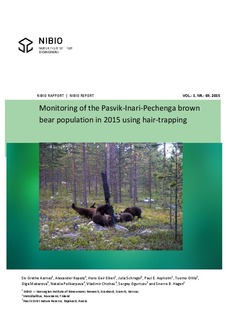| dc.contributor.author | Aarnes, Siv | |
| dc.contributor.author | Kopatz, Alexander | |
| dc.contributor.author | Eiken, Hans Geir | |
| dc.contributor.author | Schregel, Julia | |
| dc.contributor.author | Aspholm, Paul Eric | |
| dc.contributor.author | Ollila, Tuomo | |
| dc.contributor.author | Makarova, Olga | |
| dc.contributor.author | Polikarpova, Natalia | |
| dc.contributor.author | Chizhov, Vladimir | |
| dc.contributor.author | Ogurtcov, Sergey | |
| dc.contributor.author | Hagen, Snorre | |
| dc.date.accessioned | 2016-02-11T19:45:13Z | |
| dc.date.accessioned | 2016-02-12T09:11:41Z | |
| dc.date.available | 2016-02-11T19:45:13Z | |
| dc.date.available | 2016-02-12T09:11:41Z | |
| dc.date.issued | 2015 | |
| dc.identifier.citation | NIBIO Rapport. 32 p. NIBIO, 2015 | nb_NO |
| dc.identifier.isbn | 978-82-17-01531-4 | |
| dc.identifier.issn | 2464-1162 | |
| dc.identifier.uri | http://hdl.handle.net/11250/2378879 | |
| dc.description.abstract | The trans-border brown bear population of Pasvik-Inari-Pechenga (Norway-Finland-Russia) has been monitored using genetic analyses of feces collection since 2005. In addition, in 2007 and 2011, hair traps were systematically placed out in the area to collect hairs for genetic analysis, to more precisely determine the minimum numbers of bears in the area. In 2015, we repeated this hair trap study, using the exact same methodology as in 2007 and 2011, to make a direct comparison of the results from all the 3 study years. Brown bear DNA was detected in 158 of 209 hair samples (76%) obtained from hair traps in 2015 and for 136 of these samples, a complete DNA profile could be determined. We identified 26 different bears in 2015, 17 females and 9 males. We detected 16 bears in Norway, 5 bears in Finland and 9 bears in Russia. Thirteen of these 26 bears were previously unknown, 7 were detected in Norway, 2 in Finland and 4 in Russia. A comparison to the results from 2007 and 2011 showed that we detected more bears in hair traps in 2015 (26 bears) than in 2007 (24 bears) and 2011 (20 bears). We observed an increase in the total yield of hair samples in the traps in 2015 (209 samples) compared to 2007 (196 samples) and 2011 (88 samples). Four (16%) and seven (35%) of the bears caught in hair traps in 2007 and in 2011, respectively, were also recaptured in 2015. Additional samples (scats and hair) collected opportunistically in the field within the Russian and Finnish parts of the study area in 2015 detected 4 male bears and 1 female bear in the Russian part leading to a total of 14 bears identified in Russia, of which 8 bears were detected for the first time. Additional scat and hair samples from the field in Norway were not included in our study and comparisons between the systematic hair-trapping and opportunistic sampling in the field were not performed. However, the results indicate that both methods combined are currently the optimal approach to monitor brown bear numbers in an area. | nb_NO |
| dc.language.iso | eng | nb_NO |
| dc.relation.ispartofseries | NIBIO Rapport;1(69) | |
| dc.title | Monitoring of the Pasvik-Inari-Pechenga brown bear population in 2015 using hair-trapping | nb_NO |
| dc.type | Research report | nb_NO |
| dc.date.updated | 2016-02-11T19:45:13Z | |
| dc.subject.nsi | VDP::Landbruks- og fiskerifag: 900::Landbruksfag: 910 | nb_NO |
| dc.subject.nsi | VDP::Agriculture and fisheries science: 900::Agricultural sciences: 910 | nb_NO |
| dc.source.pagenumber | 32 | nb_NO |
| dc.source.volume | 1 | nb_NO |
| dc.source.journal | NIBIO Rapport | nb_NO |
| dc.source.issue | 69 | nb_NO |
| dc.identifier.cristin | 1335159 | |
| dc.subject.keyword | Bestandsovervåking / Population monitoring | |
| dc.subject.keyword | Molekylær økologi / Molecular ecology | |
